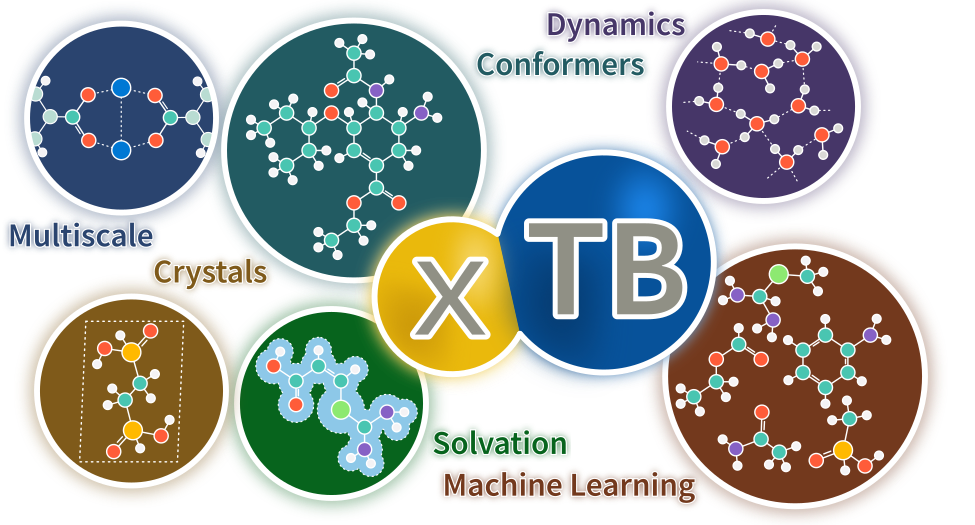xtb
The xtb program provides access to the GFN1-xTB, GFN2-xTB, and GFN-FF methods, along with various functionalities, many of which will be covered in this workshop.
A complete documentation is available online.
Beyond its functionalities, the xTB methods are known for their broad applicability to systems containing elements up to radon (Z=86), robust and efficient performance, and ease of use in practical applications.
For this workshop, please use xtb version 6.7.0 or later.

Literature
For deeper insights into the mathematical construction and technical details of the here used GFNn-xTB methods please read the original literature (excerpt):
- GFN1-xTB || Stefan Grimme, Christoph Bannwarth, and Philip Shushkov. “A robust and accurate tight-binding quantum chemical method for structures, vibrational frequencies, and noncovalent interactions of large molecular systems parametrized for all spd-block elements (Z= 1–86)”. J. Chem. Theory Comput., 2017, 13 (5), 1989-2009.
- GFN2-xTB || Christoph Bannwarth, Sebastian Ehlert, and Stefan Grimme. “GFN2-xTB—An accurate and broadly parametrized self-consistent tight-binding quantum chemical method with multipole electrostatics and density-dependent dispersion contributions”. J. Chem. Theory Comput., 2019, 15(3), 1652–1671.
- GFN-FF || Sebastian Spicher and Stefan Grimme. “Robust atomistic modeling of materials, organometallic, and biochemical systems”. Angew. Chem. Int. Ed., 2020, 59(36), 15665–15673.
- Review 1 || Christoph Bannwarth, Eike Caldeweyher, Sebastian Ehlert, Andreas Hansen, Philipp Pracht, Jakob Seibert, Sebastian Spicher, and Stefan Grimme. “Extended tight-binding quantum chemistry methods”. Wiley Interdisciplinary Reviews: Computational Molecular Science 11, 2021, 2, e1493.
- Review 2 || Albert Katbashev, Marcel Stahn, Thomas Rose, Vahide Alizadeh, Marvin Friede, Christoph Plett, Pit Steinbach, and Sebastian Ehlert, ”Overview on Building Blocks andApplications of Efficient and Robust Extended Tight Binding”. The Jpurnal of Physical Chemistry A, 2025, 129.
- mcGFN-FF || Stefan Grimme and Thomas Rose. “mcGFN-FF: an accurate force field for optimization and energetic screening of molecular crystals”. Zeitschrift fuer Naturforschung, 2024, 79(4), 191-200.
- aISS || Christoph Plett and Stefan Grimme. “Automated and efficient generation of general molecular aggregate structures”. Angew. Chem. Int. Ed., 2023, 62(4), e202214477.
- ONIOM || Christoph Plett, Albert Katbashev, Sebastian Ehlert, Markus Bursch, and Stefan Grimme. “ONIOM meets xtb: efficient, accurate, and robust multi-layer simulations across the periodic table”. Phys. Chem. Chem. Phys., 2024, 26, 12610.
Table of contents
- Installation
- General
- SP
- Solvation
- GeoOpt
- Frequencies
- MD
- PES Scans
- ONIOM
- Spin Polarization
- Periodic Calculations
- Docking
- Thermo Submodule